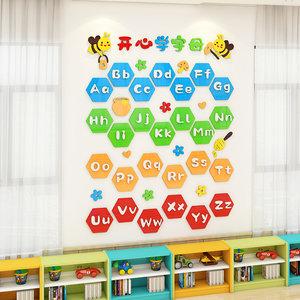Title: Designing English Early Education Wall Charts
In designing wall charts for English early education, several key considerations must be addressed to ensure their effectiveness in facilitating learning. Let's delve into the essential components and principles necessary for creating impactful and engaging educational wall charts.
Understanding the Audience:
Before diving into the design process, it's crucial to understand the target audience. English early education materials typically cater to young learners, often preschoolers or primary school children. Therefore, the design should be visually appealing, vibrant, and easy to comprehend.
Content Selection:
The content of the wall charts should align with the learning objectives and curriculum standards. Focus on fundamental English language elements such as:
Alphabets
: Include both uppercase and lowercase letters accompanied by corresponding images to aid association and memory retention.
Numbers
: Integrate numerical figures along with illustrations to assist in counting and basic arithmetic understanding.
Colors and Shapes
: Incorporate a variety of colors and shapes, reinforcing vocabulary acquisition and cognitive development.
Basic Vocabulary
: Introduce everyday objects, animals, and actions to expand vocabulary repertoire.Visual Design Elements:
1.
Color Scheme
: Choose a vibrant and stimulating color palette to capture children's attention. Utilize contrasting colors for text and background to ensure readability.2.
Illustrations
: Employ highquality, childfriendly illustrations that are visually appealing and relatable. Ensure that images are clear and easily recognizable.3.
Typography
: Select clear, sansserif fonts for improved readability, especially for young learners who are still developing reading skills. Use bold and large fonts for emphasis.4.
Layout
: Organize content in a clear and structured manner, avoiding clutter. Utilize ample white space to prevent visual overload and enhance comprehension.Interactivity and Engagement:

Consider incorporating interactive elements to enhance engagement and interactivity:
Interactive Flaps
: Integrate lifttheflap features to reveal hidden content, encouraging curiosity and participation.
QR Codes
: Include QR codes linked to digital resources such as audio pronunciation guides or interactive games for supplementary learning.
Activities
: Incorporate simple activities like matching games or tracing exercises directly onto the wall charts to promote handson learning.Durability and Practicality:
Ensure that the wall charts are durable and easy to maintain:
Material Selection
: Opt for sturdy materials such as laminated cardstock or vinyl to withstand frequent handling and potential spills.
Easy Installation
: Design wall charts with easy installation mechanisms such as adhesive backing or grommets for hasslefree mounting on walls or bulletin boards.Accessibility and Inclusivity:
Make the wall charts accessible to all learners:
Inclusive Representation
: Ensure diverse representation in illustrations to promote cultural inclusivity and representation.
Multilingual Support
: Consider incorporating translations or bilingual labels to cater to nonnative English speakers or bilingual learners.Conclusion:
Designing wall charts for English early education requires careful consideration of various factors, including audience age, content relevance, visual appeal, interactivity, durability, accessibility, and inclusivity. By incorporating these elements into the design process, educators can create engaging and effective learning aids that facilitate language acquisition and cognitive development in young learners.











